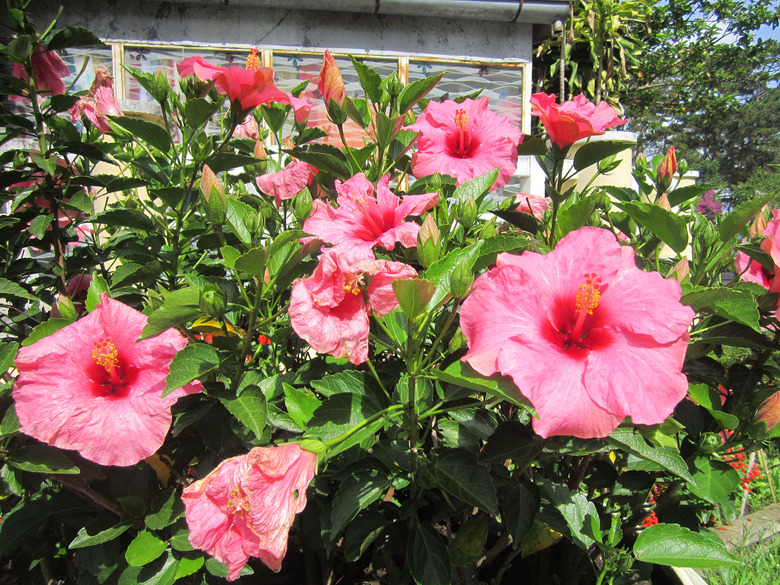Holes In Hibiscus Leaves From Pests
We may receive a commission on purchases made from links.
Hibiscus plants (Hibiscus spp.) are a beautiful addition to any garden, but they're also a prime target for pests. Pests that often leave holes in hibiscus leaves include Japanese beetles, hibiscus sawflies, and aphids. Identifying the insects that have invaded your plant's leaves is crucial to determining the right treatment method.
Attacking a Japanese Beetle Problem
Attacking a Japanese Beetle Problem
Fortunately, the beautiful, iridescent Japanese beetle has a number of natural predators, including several species of birds that are attracted to the adults and small mammals, such as raccoons and skunks, that go after the larvae that burrow underground in your lawn. If this isn't enough to stop the insects from aggressively skeletonizing your hibiscus leaves, which happen to be one of their favorite snacks, you have other options.
While these large, flashy insects are easy to spot so that you can simply pull them off your plants and drop them into a bucket of soapy water, the bad news is that they emit a pheromone that attracts other beetles to your yard. This means by the time you spot them, the invasion may be too large for you to take on by hand. If picking off the beetles by hand is impractical given the extent of the infestation, you can try setting up a Japanese beetle trap near your hibiscus plants or using a neem oil spray. This pesticide affects these leaf-eating insects but is also moderately toxic to bees and should be applied only in the early morning or late evening.
Managing Hibiscus Sawflies
Managing Hibiscus Sawflies
As you might guess from its name, the hibiscus sawfly is a pest that commonly infests hibiscus plants. These black, wasp-like insects punch holes in the plant's leaves to lay eggs that develop into ravenous green larvae that often eat all the tissue from the leaves, leaving only the veins behind.
To control these pests, prune off affected leaves, handpick the larvae from the leaves and throw them into soapy water, or apply insecticidal soap to the tops and undersides of leaves early in the morning or late in the evening to minimize harm to bees and other pollinators.
Controlling an Aphid Infestation
Controlling an Aphid Infestation
One of the most common pests on hibiscus leaves is aphids. Though they typically don't leave visible holes, they do pierce leaf, bud, and stem surfaces to feed on sap. You'll probably notice other signs of these pests, including large quantities of small white, green, black, or yellow bugs on all parts of the plant. Aphids suck the sap from plants, which can cause the leaves to turn yellow and curl or may cause new growth to turn brown and die off. Occasionally, you may also notice a sticky substance known as honeydew, which can harbor fungi, like sooty mold, that can actually kill your hibiscus by hindering photosynthesis.
While aphids can cause serious problems in hibiscus plants, the good news is that they're one of the easier pests to manage. It's important, though, to use only those techniques that won't harm beneficial insects that feed on aphids, such as ladybugs and green lacewings.
First, try spraying the plants with a garden hose to knock them off the plants. While this won't eliminate the entire problem, it will reduce the number of aphids on your plants, which may make it easier for predatory insects to make a dent in the rest of the population. If water and beneficial insects don't do the job, consider spraying the plant with a ready-to-use insecticidal soap in the late evening or early morning. This kills the insects on contact but leaves behind no residue that can hurt beneficial insects.
References
- University of California Statewide Integrated Pest Management Program: Pests in Gardens and Landscapes: Hibiscus—Hibiscus spp.
- University of Kentucky Department of Entomology: Hibiscus (Hibiscus)
- University of North Carolina: Hibiscus Sawfly
- UConn Home & Garden Education Center: Sawflies
- Safer Brand: The Story of Japanese Beetles (And How to Fight Them)
- University of California Statewide Integrated Pest Management Program: Pesticide Information: Active Ingredient: Neem Oil
- University of California Statewide Integrated Pest Management Program: Pesticide Information: Active Ingredient: Soap
